 Dr Jemma Geoghegan: “We're trying to bring together New Zealand's best in virus genomics and build a framework for future emergent virus events.”
Dr Jemma Geoghegan: “We're trying to bring together New Zealand's best in virus genomics and build a framework for future emergent virus events.”Sequencing the genome of all New Zealand's COVID-19 cases will provide valuable insights into how disease spreads around the country.
Evolutionary virologist Dr Jemma Geoghegan (Microbiology and Immunology) is heading a nationwide group involving ESR and universities tracking how the virus came into New Zealand and worked its way through the country.
“Genomics can tell us, for example, how the virus is evolving and spreading through space and time and which variants of the virus end up in which geographical location. Cases of the virus in New Zealand arrived here from all over the world.”
Geoghegan says genomes can provide insights that epidemiological data cannot. “We can help link a case to a cluster, for example, to which epidemiologically-wise there is absolutely no link; but using the genome we can link that sample to a known cluster or exclude it from a cluster.”
One example involved two patients in Wellington who came in on the same flight from America and got sick about the same time.
“Epidemiological data assumed that they probably infected each other and were a cluster, but looking at the viral genome from those two patients we actually saw that there was too much divergence in those viruses for those two people to have infected each other. They both got infected in the States, but probably from two different sources of the virus. “
This sort of information was invaluable when there was a resurgence of the virus in South Auckland, enabling policy-makers to link cases to a known cluster, to measure the effectiveness of lockdown measures and, by looking for any genomic diversity, seeing whether or not there was undetected community transmission.
“We're trying to bring together New Zealand's best in virus genomics and build a framework for future emergent virus events. A lot of benefit of sequencing virus genomes during a pandemic is doing real-time genomic sequencing and analyses because we can understand what's happening right now with the virus.
“No one really saw this coming – this scale of pandemic – so now, at least, the right people are talking to each other and we have built capacity to be able to do this for any future event.”
Funding
Ministry of Business, Innovation and Employment
